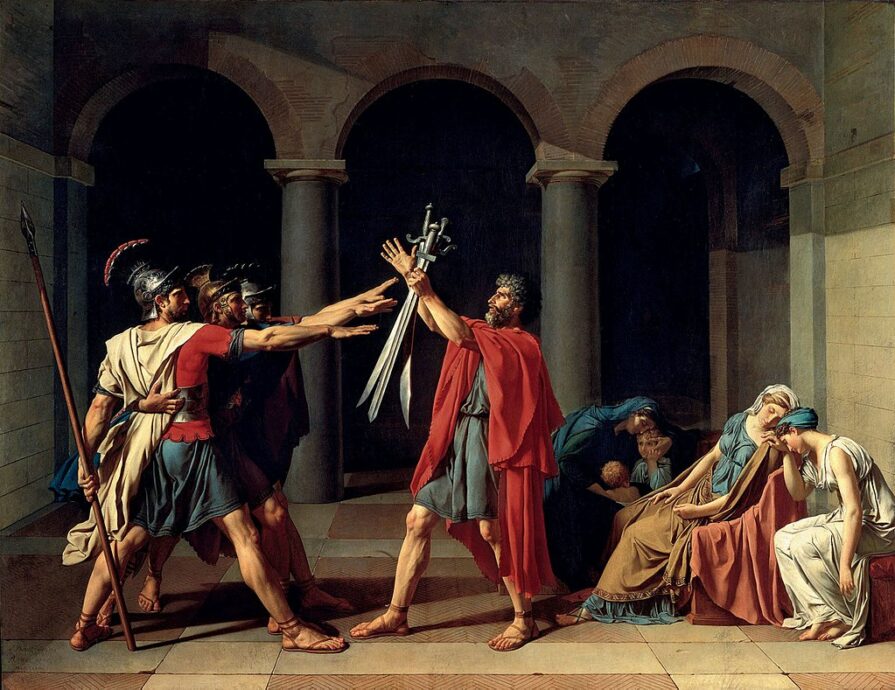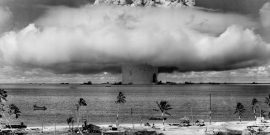Are We Focused On The Wrong Rome?
In April 2021, The Atlantic ran a long article by Cullen Murphy entitled “The Fall of Rome All Over Again?” Its subject was the purported similarities between the position of the United States today and the Roman Empire when it toppled. A year later, Salon published a piece called “8 striking parallels between the U.S. and the Roman Empire.” Then, this past October, Foreign Policy magazine offered its readers an extended analysis of the topic through a review of the new Peter Heather and John Rapley tome, Why Empires Fall: Rome, America and The West. These are merely the most prominent examples of the emergence of a new literary genre: the analogous study of the ancient Roman empire and the present-day United States.
As our species has a tendency towards group-think and this problem particularly affects intellectuals, it might be worthwhile to pause for a moment and ask if we are presenting ourselves with the right question—or making the right comparison.
The Roman Empire’s decline began with the death of Marcus Aurelius in 180 AD. Unlike the four “good emperors” who preceded him, Marcus Aurelius selected a blood relation as a successor, his evil son Commodus. Commodus’s sanguinary rule ended in 192 AD with his assassination. The century that followed is sometimes referred to as the Third Century Crisis since so much went wrong during its length. The troubles were particularly acute in a period stretching from 235–284 AD. Sometimes also referred to as the Imperial Crisis, this half-century saw 26 different men claim the title of Emperor, and by its end, there was a de facto division of the Empire’s territory into three separate regions: the Gallic Empire, which included France and Britain; the Palmyrene Empire, which included Palestine, Syria, and Egypt; and the main one, which focused itself within the Italian Peninsula.
There was then a partial recovery of the Empire’s old might as it was reunited under Aurelian and reconstituted under Diocletian. The latter created a new system under which there were four rulers, or tetrarchs, each placed nearer to the Empire’s borders. This eventually led to a split in which one Emperor ruled in Constantinople and another in Rome.
That was followed by a longer period of decline that concluded with the fall of the Western empire. This event is generally dated to the death of Romulus Augustulus in 476 AD, although it’s worth noting that no one at the time thought the Empire had disappeared since nominal figures were claiming the title of Western Roman emperor for decades afterward.
During the long period of Rome’s decline, there were many problems. One of the worst was inflation, caused by debasement of the currency. In the third century, inflation rates ran to 35% per year. Diocletian responded to this by imposing nearly universal price controls on both wages, goods, and services. This produced famine and a ruination of the economy of the urban centers of the Western empire. The enduring damage to Rome and many other cities began a process in which they were depopulated as city-dwellers moved back to the countryside. Yet Diocletian’s price edicts did not stop the inflation. In fact, thirteen years after he had tried to prevent further price increases, the cost of wheat was reported to be 57 times higher.
The Western empire was also tried by frequent invasions of barbarian hordes. With this, there came a heavy reliance upon foederati: foreign legions inside the ranks of the military. Moreover, as Rome’s only means of selecting its emperors was through contests of military power, it saw repeated civil wars between competing generals, and its tax base increasingly went not towards the upkeep of the empire but to rewarding soldiers loyal to the latest usurper.
And what was its economy like? Rome’s great estates, called latifundia, provided its food. But, throughout its history, it was greatly dependent upon the wheat produced in the Nile River Valley, and to that end, it worked its Egyptian slaves so brutally that the average life expectancy among them seems to have been no more than twenty, if that. However, everywhere in the empire there was a reliance upon either slave labor or upon barely free rural populations who lived in a condition approaching serfdom. When this was combined with the autocratic and confiscatory nature of Roman imperial rule, there was necessarily little innovation or invention, and its economy was moribund.
Now ask yourself if any of this sounds like America today. Have we had prices rise 35% each year? Do we depend upon slaves to feed ourselves? Do we have foreign legions within our army? Do the bulk of our taxes go towards rewarding soldiers loyal to the latest usurper? Do we have an economy void of innovation or invention? Are our cities depopulated? Are our politicians generals who achieve power by fighting other generals?
Obviously, our country is not like this.
The irony is that there is a worthwhile and important example from ancient times that is worthy of our study, one that our founding fathers pointed to frequently: the fall of the Roman Republic.
There is no guarantee that a grossly indebted nation without a healthy middle class will always be free.
Because our country is young, we may be inclined to forget a simple fact: ours is the oldest constitutional republic in the world. The Roman Republic was likewise long-standing. Indeed, as the Republic existed from 509 BC to 27 BC, it lasted for nearly as long as the Western half of the Roman Empire sustained itself. Over the course of this time, the Republic went through a long process of transformation in which it was democratized and the power and status of the patrician class diminished. So divided initially were the aristocrats from the commoners in the Republic that when Rome’s early law code, the Twelve Tables, was first presented in 451 BCE, the plebeians were not even permitted to marry patricians.
The strength of Rome’s legions and the militaristic nature of the Roman society that supported and organized those armies provided the basis for Rome’s expansion, and most of the territory within its eventual empire was acquired during the Republic. Ironically, this growth was especially rapid during the Republic’s decline. In fact, the fall of the Republic is very much connected to its military conquests.
Rome did not defeat Carthage until 146 BC. From that point on, there was no real power to rival it in the Mediterranean. However, the legions were occupied for some decades afterward in dealing with slave revolts and uprisings among its supposedly welcoming but actually oppressed and resentful would-be allies in the Italian peninsula. These conflicts are known, respectively, as the three Servile Wars and the Social Wars.
The growth of the Republic sped up greatly after 100 BC. In 96 BC, Libya (Cyrene) was essentially given to Rome. In 86 BC, Rome took possession of Athens, and by 64 BC it had gained effective control over the rest of the Greek city-states of the Eastern Mediterranean. In the same year, it captured Syria. By 51 BC, Caesar’s legions had conquered Gaul: France and Belgium. Then, within just another three years, Caesar’s armies were in possession of the South coast of the Black Sea and Egypt.
These conquests were mostly bad for ordinary Romans. The wheat from Egypt and many other newly conquered regions drove down the price of grain. That impoverished average Roman farmers. Left landless, they went to the capital. Roman politicians dealt with this by creating a giant welfare scheme in which once productive, hardworking citizens were placed on the dole. Romans devised a term for this group which soon numbered in the hundreds of thousands—a third of the total population of the city. They were referred to as the mobile vulgus. It is from this expression that we get the term mob. Lacking work and with much time on their hands, they gravitated towards the politicians who could provide them with money or occasional employment, and many became hired thugs employed by these demagogic politicians. This led to violent division on Rome’s streets.
Meantime, Rome’s conquests expanded the slave population of the Republic. During the conquest of Gaul alone, Caesar and his armies took—and then sold—more than one million people. This created immense wealth for a small number of people. It also provided the Senate with money to pay for all the welfare in Italy’s urban centers. Thus, the conquests had the dual effect of making a handful of people into a class of idle rich and a much larger number into the idle poor. And to keep the idle poor occupied and to prevent them from becoming restless, republican politicians provided not just free bread but circuses and other grand forms of popular entertainment.
Since the early 1970s, income inequality in the United States has increased dramatically. We have more and more idle rich and idle poor. As we all know, trade with other nations—China especially—has reduced the value of unskilled domestic labor. This problem, of course, has been worsened by the flood of illegal immigrants into the country. The changes that destabilized the Roman Republic and empowered demagogic politicians appealing to landless folk who once owned property are not entirely unlike what has been happening in the United States. Our welfare state continues to grow. At the same time, many intellectuals take seriously the notion that the absence of gainful employment can be remedied through programs like “midnight basketball.” Perhaps even worse is the idea of a basic, universal income.
By no means is our position just like Rome during the late Republic. We do have a serious military rival in China. And we do not have slaves, though migrant workers, both legal and illegal, employed on our farms and in sweatshops across Asia and Mexico may sometimes perform similar functions for our economy.
The idea that foreign trade and immigration are unalloyed benefits needs to be more intensively questioned. For one thing, trade deficits do not even increase our gross domestic product. They reduce it. To the same degree, we must critically examine the impulse to place our troops in every part of the globe. Unlike Rome, we are not using our legions to plunder weaker nations. But, as we are not, we are impoverishing ourselves, and there is no guarantee that a grossly indebted nation without a healthy middle class will always be free. After all, a society composed of rentiers on the one hand and semi-employed Walmart greeters receiving free health care on the other will inevitably prove unstable. The example of ancient Rome should tell us that—Republican Rome.


